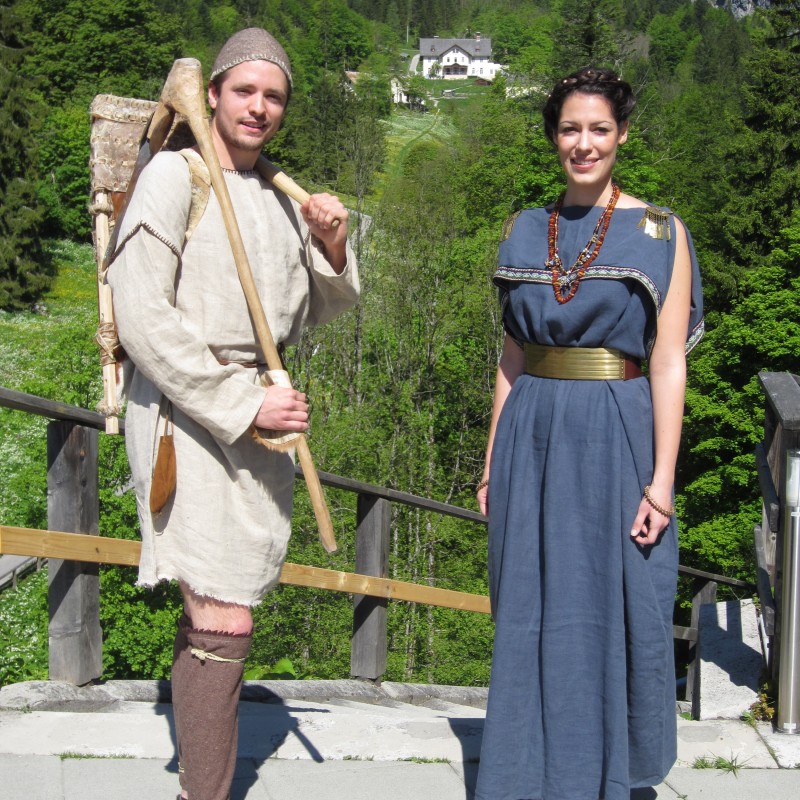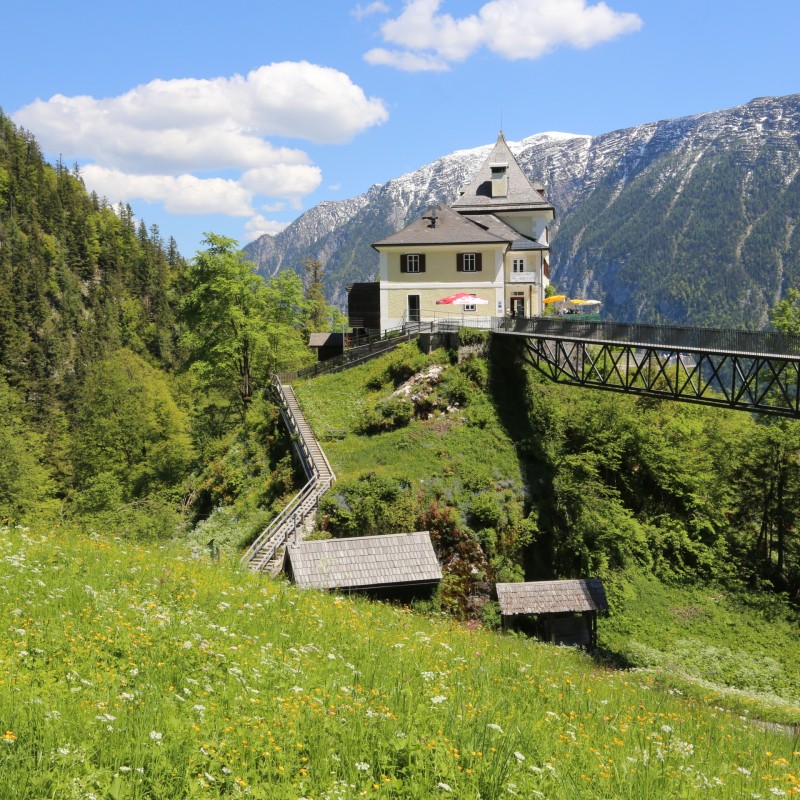Austrian World Heritage Day on 18 April 2022: NHM Vienna celebrates three World Heritage sites
11. April 2022
This year's World Heritage Day marks a special anniversary: the World Heritage Convention was launched 50 years ago, and Austria
ratified the Convention 30 years ago. Three World Heritage sites are associated with the Natural History Museum Vienna: Hallstatt,
the Wachau and the prehistoric pile dwellings in the Alpine region. A wide variety of events is scheduled to celebrate these
sites on and around 18 April 2022.
Since 1982, the International Day of Monuments
and Sites, also known as World Heritage Day, has been dedicated to the UNESCO World Heritage with the aim of raising awareness
about the unique splendour of the world's cultural and natural heritage.
The Natural History Museum (NHM) Vienna has close links with 3 of 12 Austrian World Heritage Sites:
Hallstatt:
The Hallstatt branch of the NHM is dedicated to an exploration of the prehistoric mines, the history of 7,000 years of salt production, and to the emergence and evolution of this unique salt region from the Stone Age to the present day. Prehistory experts explore tunnels and salt mining chambers in the Hallstatt salt mountain and produce reconstructions that present a vivid picture of the way of life, the working conditions, the tools, the fashion and even the burial system of the people who lived here thousands of years ago. “7,000 years of uninterrupted salt production in Hallstatt are what makes this World Heritage site and the entire region so special – it is of incredible value for our prehistoric research, but also for current salt production,” says the Director General of the NHM Vienna, Dr Katrin Vohland. The research activities in Hallstatt are conducted in cooperation with Salinen Austria AG and Salzwelten GmbH.
UNESCO added Hallstatt to its World Heritage List in 1997, which makes 2022 another anniversary year: 25 years of the World Heritage site Hallstatt-Dachstein/Salzkammergut.
Wachau:
Human activity in the Wachau region began in the Palaeolithic Age. The Wachau constitutes an outstanding example of a riverine landscape with remarkably well preserved evidence of its long historical evolution. A find of great significance took place in 1908: first NHM excavations conducted by Josef Szombathy, Josef Bayer and Hugo Obermaier unearthed the Venus of Willendorf – the world-famous figurine made from oolitic limestone 29,500 years ago. Today, the Venus of Willendorf is exhibited in its own room in the Natural History Museum – next to another prehistoric figurine from the Galgenberg near Stratzing/Krems-Rehberg (36,000 years old). Since 2000, 15 municipalities and an area of 18,461 hectares have been part of the UNESCO World Heritage site Wachau.
The Board of Trustees on Pile Dwellings:
Sunken lakeside settlements – pile dwellings – reveal insights into prehistory at the lakeshores in Upper Austria and Carinthia. Similar to the salt mine in Hallstatt, organic materials that have been irretrievably lost in other sites have been conserved here by submersion in the water. Since 2011, five Austrian sites have been part of the UNESCO World Heritage site “Prehistoric Pile Dwellings around the Alps”. The management of these World Heritage sites has been entrusted to a Board of Trustees. The Board has its office at the NHM Vienna, which facilitates close professional cooperation with the NHM’s Research Department of Prehistory and Early History and the joint presentation of findings.
The programme on World Heritage Day, 18 April 2022 from 2:00 p.m. (in German language)
World Heritage Festival on Lake Hallstatt at the Strandbad Bad Goisern. Stations on the following topics:
Salt
The history of salt production from its beginnings in the Stone Age to the present day: test the picks used by Bronze Age miners and learn how salt is produced today. Use VR glasses to become immersed in the world of the prehistoric miners or go on a virtual exploration of the archaeological excavation sites.
Water
For thousands of years, the Traun River and the lakes of the Salzkammergut were the main route for shipping salt. Try out how to steer a boat made of animal skins and go boating on the lake.
Even today, there is a close connection between water and salt: water is used to wash the salt from the mountain. See how salt is produced today.
Wood
7,000 years of wood: for millennia, wood was the most important resource for salt production. Find out about the diverse uses of wood through the ages. Test a Bronze Age hatchet or try your hands at the pull saw that lumberjacks used 100 years ago.
Culture, Nature, Crafts
Experience the diversity and uniqueness of the region’s culture, crafts and scenic beauties. Museums, schools and associations present the diversity of this fascinating landscape.
Starting at 17:30:
Celebration of “25 years Welterbe Hallstatt-Dachstein/Salzkammergut” featuring the three Upper Austrian World Heritage Sites (Strandbad Bad Goisern) .
Other events in celebration of World Heritage Day (in German language):
Welterbe-Talk „Schutz des Kulturerbes unter Wasser“
Online Talk
22 April 2022, 17:00 - 18:30, Zoom
Guided tours above and below the water:
Pfahlbauten hautnah – Tauchexkursion See am Mondsee
18 April 2022, See am Mondsee, 4866 Unterach am Attersee
Führung durch das Museum ATARHOF und den prähistorischen Garten beim Pfahlbaupavillon
18 April 2022, 10:00 – 17:00
ATARHOF, Landungsplatz 1, 4864 Attersee am Attersee
Führungen der Pfahlbauvermittler*innen beim Pavillon Seewalchen
23 April 2022, 10:30 – 12:00, Agerbrücke / Promenade, 4863 Seewalchen am Attersee
UNESCO-Welterbe Pfahlbauten und mehr – Ein Blick in die Vergangenheit von Keutschach
23 April 2022, 14:00 – 16:00, Strandbad Keutschach, 9075 Keutschach
Links:
www.nhm-wien.ac.at/welterbetag
www.welterbetag.at/
www.dachstein-salzkammergut.at
www.pfahlbauten.at/welterbetag
The Natural History Museum (NHM) Vienna has close links with 3 of 12 Austrian World Heritage Sites:
Hallstatt:
The Hallstatt branch of the NHM is dedicated to an exploration of the prehistoric mines, the history of 7,000 years of salt production, and to the emergence and evolution of this unique salt region from the Stone Age to the present day. Prehistory experts explore tunnels and salt mining chambers in the Hallstatt salt mountain and produce reconstructions that present a vivid picture of the way of life, the working conditions, the tools, the fashion and even the burial system of the people who lived here thousands of years ago. “7,000 years of uninterrupted salt production in Hallstatt are what makes this World Heritage site and the entire region so special – it is of incredible value for our prehistoric research, but also for current salt production,” says the Director General of the NHM Vienna, Dr Katrin Vohland. The research activities in Hallstatt are conducted in cooperation with Salinen Austria AG and Salzwelten GmbH.
UNESCO added Hallstatt to its World Heritage List in 1997, which makes 2022 another anniversary year: 25 years of the World Heritage site Hallstatt-Dachstein/Salzkammergut.
Wachau:
Human activity in the Wachau region began in the Palaeolithic Age. The Wachau constitutes an outstanding example of a riverine landscape with remarkably well preserved evidence of its long historical evolution. A find of great significance took place in 1908: first NHM excavations conducted by Josef Szombathy, Josef Bayer and Hugo Obermaier unearthed the Venus of Willendorf – the world-famous figurine made from oolitic limestone 29,500 years ago. Today, the Venus of Willendorf is exhibited in its own room in the Natural History Museum – next to another prehistoric figurine from the Galgenberg near Stratzing/Krems-Rehberg (36,000 years old). Since 2000, 15 municipalities and an area of 18,461 hectares have been part of the UNESCO World Heritage site Wachau.
The Board of Trustees on Pile Dwellings:
Sunken lakeside settlements – pile dwellings – reveal insights into prehistory at the lakeshores in Upper Austria and Carinthia. Similar to the salt mine in Hallstatt, organic materials that have been irretrievably lost in other sites have been conserved here by submersion in the water. Since 2011, five Austrian sites have been part of the UNESCO World Heritage site “Prehistoric Pile Dwellings around the Alps”. The management of these World Heritage sites has been entrusted to a Board of Trustees. The Board has its office at the NHM Vienna, which facilitates close professional cooperation with the NHM’s Research Department of Prehistory and Early History and the joint presentation of findings.
The programme on World Heritage Day, 18 April 2022 from 2:00 p.m. (in German language)
World Heritage Festival on Lake Hallstatt at the Strandbad Bad Goisern. Stations on the following topics:
Salt
The history of salt production from its beginnings in the Stone Age to the present day: test the picks used by Bronze Age miners and learn how salt is produced today. Use VR glasses to become immersed in the world of the prehistoric miners or go on a virtual exploration of the archaeological excavation sites.
Water
For thousands of years, the Traun River and the lakes of the Salzkammergut were the main route for shipping salt. Try out how to steer a boat made of animal skins and go boating on the lake.
Even today, there is a close connection between water and salt: water is used to wash the salt from the mountain. See how salt is produced today.
Wood
7,000 years of wood: for millennia, wood was the most important resource for salt production. Find out about the diverse uses of wood through the ages. Test a Bronze Age hatchet or try your hands at the pull saw that lumberjacks used 100 years ago.
Culture, Nature, Crafts
Experience the diversity and uniqueness of the region’s culture, crafts and scenic beauties. Museums, schools and associations present the diversity of this fascinating landscape.
Starting at 17:30:
Celebration of “25 years Welterbe Hallstatt-Dachstein/Salzkammergut” featuring the three Upper Austrian World Heritage Sites (Strandbad Bad Goisern) .
Other events in celebration of World Heritage Day (in German language):
Welterbe-Talk „Schutz des Kulturerbes unter Wasser“
Online Talk
22 April 2022, 17:00 - 18:30, Zoom
Guided tours above and below the water:
Pfahlbauten hautnah – Tauchexkursion See am Mondsee
18 April 2022, See am Mondsee, 4866 Unterach am Attersee
Führung durch das Museum ATARHOF und den prähistorischen Garten beim Pfahlbaupavillon
18 April 2022, 10:00 – 17:00
ATARHOF, Landungsplatz 1, 4864 Attersee am Attersee
Führungen der Pfahlbauvermittler*innen beim Pavillon Seewalchen
23 April 2022, 10:30 – 12:00, Agerbrücke / Promenade, 4863 Seewalchen am Attersee
UNESCO-Welterbe Pfahlbauten und mehr – Ein Blick in die Vergangenheit von Keutschach
23 April 2022, 14:00 – 16:00, Strandbad Keutschach, 9075 Keutschach
Links:
www.nhm-wien.ac.at/welterbetag
www.welterbetag.at/
www.dachstein-salzkammergut.at
www.pfahlbauten.at/welterbetag



